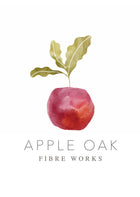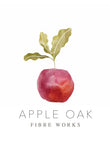Archives: The sowing & growing of Woad ~ a research project 2022
After using our local Irish Woad for the last few years, I was curious to try out other strains. I am very lucky that Irish Seedsavers Association has agreed to produce Organic Seed from Popular dye plants another step into the right direction to Sustainable Natural Dyeing practices. We are currently growing 3 strains of Woad: Our Irish Woad, Woad 'Tewkesbury' from the UK and Woad 'Birmingham' from Canada. 'Birmingham was given to us by a member of 'The Woad Project' Facebook group.
To make this a shared experience, we decided to turn it into a hands on workshop, giving others the possibility to learn and experience working with an ancient Dye plant. We met up in April for the first part of the Workshop, where Tristan covered the seed to seed cycle of Woad. All participants learned about sowing rates, seedlings, potting on, soil preparations, feeding the plants, harvesting and seed growing.

Tristan showing how to pot on seedlings

Potting on seedlings

Soil preparation talk

The magic of hoeing - showing the early Weld plants.
Findings:

Woad Tewkesbury
- Germination 6 days after sowing
- With the first harvest 3 months later.
- Even growth, strong and vibrant plant.
- Abundance of fleshy, juicy leaves.


Woad Birmingham
- Germination uneven about 8 days, 50% of seedlings not very uniform 25% small
- First harvest 3months later, plants have caught up to Tewkesbury, if slightly slimmer leaf, serrated leaf edge

Irish Woad
- Germination uneven only 46% germinated and 50% off those are small
- erratic growth pattern
- Above plants shown at 3 months, before 1st harvest.
All three plants were harvest after 3 months of growth to make the first batch of fermented Woad for Woad balls. As it is obvious, the Irish strain struggled immensely in comparison to the other two. So you can imagine my surprise when I returned to the field 2 weeks later to find the Irish strain as strong and even as the Birmingham and the Tewkesbury strain!
After cutting the leaves for the first time, blue sap was visible and strongest in the Tewkesbury and the Irish strain. From left: Tewkesbury, Birmingham, Irish



After cutting, the plants were treated to a feed of chicken pellets, garden compost and seaweed dust. These were worked into the soil using a hoe, to make sure the feed would not be washed away with the next rain.


Two weeks after the first cut. Tewkesbury on the left and the picture on the right, right side of the wooden board, shows Irish Woad in the front, followed by Birmingham in the 2nd third. You can see that the Irish Woad has caught up significantly.

On the 2nd of July (2 weeks after the first cut) the first half of the group came back for the second harvest. All the plants, as shown above, were harvested (24kg), the same amount I harvested two weeks before.

Though we only cut the outer leaves away that time, to have enough in two weeks time to work with.
Since then, I have talked to other Woad growers in different countries and one thing stands out: Woad needs Water. We had a slow Summer this year, it stayed cold for a very long time (mid teens) way into May with a good amount of rain at regular intervals, something we are generously blessed with here in Ireland.
Since the second harvest, the Woad has grown immensely. I didn't have time to do another cut, unfortunately, for some reason my children are not as excited about natural dyeing as I am...and we have over two months of summer holidays...
Nonetheless, I have been visiting regularly and our next harvest will be on the 12th of August for another fermentation for Woad balls. Two weeks later, the 4th cut will happen on the 27th of August.



Hi Lucy, thank you! Sure! Please visit our seeds here https://appleoakfibreworks.com/collections/seeds-grow-your-own-dye-plants
Thanks for sharing your results Jennifer. Very interesting; I have seeds that I saved from 2 years ago. I must see if they are still viable otherwise I would like to try some of the Birmingham.
Thanks for sharing your results Jennifer. Very interesting; I have seeds that I saved from 2 years ago. I must see if they are still viable otherwise I would like to try some of the Birmingham.
Thank you Helena! Looking forward to seeing the results! 😊
Oh wow, really good to see that it’s going so well isn’t it! Delighted for it.
Looking forward to getting more into dye plants and test them on our wool.
Leave a comment